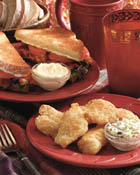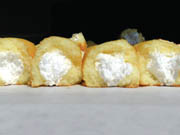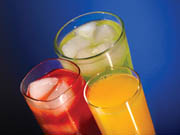Ingredient Challenges: Emulsifiers Offer Options

Growing up, we learn that certain things tend not to mix: cats and dogs, gasoline and fire, liberals and conservatives and oil and water. Yet, when the need arises, these disparate entities can and are mixed. In food product development, oil and water often are mixed in formulations. Both are integral parts of most food systems and, as much as health-conscious individuals do not wish to acknowledge it, fats and oils are dietary necessities.
However, oil and water cannot mix without help. The enabler generally occurs in the form of emulsifier ingredients that assist in getting two immiscible liquids to mix and stay mixed. According to the Lipid Glossary 2 (2000, eds. Gunstone, FD and Herslof, BG, The Oily Press), an emulsifier is defined as “a surface-active compound which promotes the formation of emulsions between water and fatty or oily compounds. Important in cleaning processes and also in many foods.”
The glossary goes further: “a variety of emulsions exist in food. Examples include margarine, butter, and mayonnaise (semi-solid; water-in-oil emulsions), milk and dressings (liquid; oil-in-water emulsions) and ice cream (mixture).”
To better understand how to use emulsifiers, it is important to explore the chemistry behind these ingredients and how that chemistry may be manipulated in foods and ingredients.

Immersing in Emulsifiers
When a food processor sets out to produce an emulsion, the primary goal is to create small droplets--often through mixing and shearing--which then must be stabilized. To ensure the desired emulsion is properly stabilized, an emulsifier is employed. Emulsifiers have components in their molecular structure that are soluble in oil (lipophilic or fat-loving) and in water (hydrophilic or water-loving). Different emulsifiers are categorized as being ionic or non-ionic. Ionic compounds may be cationic, anionic or amphoteric. Ionic emulsifiers have a problem; however, they can react with various ions to form complexes that adversely affect performance. Non-ionic emulsifiers tend not to react with ions and are used most extensively in the food industry.Perhaps the easiest way to envision how an emulsifier works is to think of hand washing. If salad oil or beef fat gets on one's hands, experience shows that simply rinsing them with water does not get them clean. Running cold water over them after handling animal fats causes the fat to congeal, which is not a pleasant experience. Hot or warm water partially melts the fat, but does not remove it. Soap, acting as an emulsifying agent, promotes the formation of an emulsion between the oil and water so that hands are cleaned.
Emulsions can take several forms. In an oil-in-water (O/W) emulsion, the water surrounds the fat globules, which are dispersed throughout the oil; the emulsifier acts to form a micelle as concentrations of emulsifier increase. The fat-soluble portions of the molecule are in the fat and the water-soluble parts in the water. The water-in-oil emulsion (W/O) is the opposite, with water dispersed throughout the fat matrix. Micelles may be spherical, rod-shaped or lamellar. Proper use of emulsifiers allows manufacturers of salad dressings, which generally have high levels of fats, to reduce the fat content and, hence, calories. Processors can further manipulate emulsion systems to create water-oil-water (W/O/W) type emulsions. In these systems, water is dispersed within O/W emulsions. And, of course, if there are W/O emulsions, it also is possible to make oil-water-oil products. However, most of the emulsions that are used in foods are of the first two types.
Since so many different types of emulsifiers are available to the food processor, the industry has developed a system to determine what kind of system should be employed to create the desired products quickly, efficiently and, most important, economically. The system, called the HLB Method, which stands for “Hydrophile-Lipophile Balance,” is defined as the ratio of the weight percentages of the hydrophilic and hydrophobic groups in an emulsifier. Emulsifiers with HLB values below 9 are lipophilic, those with values between 11 and 20 are hydrophilic and those with values between 8 and 11 are intermediates. The solubility of an emulsifier in water will, therefore, increase as its HLB value increases. (See chart “Helpful HLB Values.”) As the HLB value increases, the dispersability of that compound in water will increase along with the clarity of the solution that is formed. For example, the use of an intermediate level product, that is an emulsifier with an HLB value of between 8 and 10, will yield a stable solution that appears milky. Using a product that has an HLB value of greater than 13 will give the user clear solutions.
Functions in Foods
Emulsifiers perform many functions in foods. The type of emulsifier that is used in a particular application depends upon the desired end product and the processing system that is being used. The use of emulsifiers in spreads and dairy desserts has been noted, but they also are used in breads, tofu, instant mashed potatoes, chewing gums, flavors, noodles, powdered products, beverages, chocolates and even in deep-fat frying. When producing emulsifiers, manufacturers look for certain characteristics. These include:1. Ability to reduce interfacial tension,
2. Rapid absorption at the interface,
3. Proper balance of hydrophilic and hydrophobic groups to stabilize different kinds of emulsions,
4. Functions effectively at low concentrations,
5. Ability to resist chemical changes,
6. No odor or color,
7. Non-toxicity and
8. Economy.
Perhaps the easiest product to envision is mayonnaise, a water-in-oil emulsion. Pick up a jar of regular mayonnaise and look at the ingredient statement. The list may read as follows: soybean oil, water, whole eggs and egg yolks, vinegar, salt, sugar, lemon juice, EDTA and natural flavors. In this product, the eggs, particularly the egg yolks, act as the emulsifier. Egg yolks contain phospholipids, which are an ionic emulsifier. Another commonly used phospholipid emulsifier is soybean lecithin. This is a valuable by-product of the refining process for soybean oil. The lecithins that are used commercially are generally fractionated into alcohol-soluble and insoluble fractions in an effort to ensure the end product is rich in phospholipids.
One of the more interesting applications of emulsifiers is in chewing gum. People chew gum for extended periods of time yet the gum does not stick to their teeth. The natural enamel on teeth is hydrophilic so gum should not stick. That is not the case with artificial teeth. The addition of an emulsifier, which is a good wetting agent, will help to minimize this concern. Selection of an emulsion that has an intermediate HLB value would be your ticket.
Emulsifiers may be used in doughs for breads and cakes to enhance dough conditioning, ensure the product rises properly and inhibit staling. In these situations, the actions are not emulsification but conditioning. The emulsifier, for example, a mono- or diglyceride, would react with the protein component in the flour to make the bread rise smoothly. It would also react with the starch to ensure the bread is soft. Mono- and diglycerides are one of the most commonly used systems in food processing. They generally are inexpensive and prepared from triglycerides. Depending upon how the oils are processed, ingredient suppliers can manipulate the concentrations of mono- and diglycerides in the end product. The hydrophilic character of monoglycerides may be increased by introducing carboxylic acids such as lactic or succinic acid to the molecule.
Emulsifiers also indirectly help in the production of fried foods. Michael Blumethal's Surfactant Theory of Frying basically states that for food to fry properly, compounds that reduce the surface tension between frying oils and foods, which are mostly water, are required. These surfactant compounds, such as salts of fatty acids, phospholipids and others, all are products that have some emulsifying properties. There are some frying oils that have incorporated low levels of mono- and diglycerides in an effort to “jump start” the frying process, but in the long run, such materials can compromise the fry life of the oil.
In food products that are based on emulsions, that emulsion must be stable. If the emulsion destabilizes during shipping or when the product is displayed on a retail shelf, it will cost the manufacturer money and headaches. An example of such a problem is known as creaming. In this case, the emulsion eventually simply separates into two layers. This is caused by flotation or sedimentation of dispersed droplets. For this reason, many manufacturers use a combination of emulsifiers or materials that will help maintain stability. This may be accomplished by inducing a strong interfacial film around each droplet, adding electric charges to the surface of the droplets or increasing the viscosity of the continuous phase of the emulsion. One of the means by which this is accomplished is through the use of fine particulates, such as coagulated proteins or seasonings and spices. The finely ground spices that are used in so many salad dressings, dipping sauces and other products not only add flavor, but help stabilize the emulsion.
Emulsifiers are an integral part of food manufacturing and product development. They are used in a wide range of products and processes and do more than allow immiscible fluids to come together. They enhance textures, flavors and mouthfeel of foods. When selecting an emulsifier, work with your suppliers, but make an effort to understand what HLB values are. This is the scale by which emulsions are rated and is crucial to finding a product that will meet your needs.

Showcase: Emulsifiers and Fats and Oils
Gum Arabic commonly is used to stabilize beverage emulsions but it is imported from often unpredictable sources. EmCap[tm] modified starches from Cargill Food & Pharma Specialties are cost-effective alternatives to gum Arabic and provide health benefits over animal-derived sodium caseinate. The starches emulsify oil and water solutions in beverages, liquid and dry clouds and salad dressings. Flavor emulsions and finished beverages show no oil separation or ringing after six months at room temperature. Learn more about EmCap and other modified starches derived from tapioca and common maize. Cargill Food and Pharma Specialties, 877-650-7080, www.cargill.comTake flavor in stock. Hormel Specialty Products' line of Great Beginnings® meat stocks are 100% natural, water-soluble and high in protein. All Hormel stocks are derived from slowly cooked bones, muscle and meat to extract the flavors and aromas most important to your finished product, and "flash" sterilized to ensure product wholesomeness. Hormel is ready to put its expertise to work for you. Hormel Specialty Products, Mike Buttshaw, 800-956-0399, www.hormel-spd.com
A company that specializes in custom development can meet a wide range of formulation requirements. Ventura Foods is a full line producer of shortenings, oils, margarines, butter blends, sauces and marinades, with 12 manufacturing and distribution locations. Ventura Foods strives to meet technology hurdles by utilizing industry-experienced R&D, QA and operations staff. Working together on state-of-the-art systems, personnel can design products to meet a wide range of client needs. The company also provides the best economical and practical packaging and delivery systems for all of its products. Ventura Foods LLC, Frank Stynes, 800-326-2253, fstynes@venturafoods.com, www.venturafoods.com
There is now a solution to trans-fat reduction. Sta-Crème is a low-trans fat and low-calorie emulsifying and stabilizing system for the production of icings, cream fillings, whipped toppings and aerated frozen desserts, with nutritional advantages over standard systems. Sta-Crème excels in products that require a creamy mouthfeel and aeration. Additionally, it provides excellent freeze-thaw stability to highly aerated frozen desserts. Products made with Sta-Crème are relatively unaffected by freezing and are extremely stable in hot conditions. American Ingredients Co., Paul Barnes, 816-561-9050, ext.1384, barnes@americaningredients.com, www.americaningredients.com
For rich and creamy sauces and dressings with labels that say “natural,” reach for real eggs. Whole egg and yolk products naturally emulsify immiscible ingredients, creating smooth and silky textures. In fact, egg products have functional properties that naturally do the job of many additives--but with a clean ingredient label. Formulas and/or technical assistance are available. American Egg Board, EGGSolutions: 877-488-6143, www.aeb.org
A qualified health claim is now allowed by the FDA for olive oil. Kerry Americas' trans-free virgin olive oil powders are the essential olive oil for side dishes and pre-packaged dinner sauces, snack seasonings, sauce bases, cream soups and nutritional bars. Containing 70% virgin olive oil, the products are spray-dried for ease in storage and handling in formulations from benchtop to production; the powders have a 12-month shelflife. Kerry Specialty, Erin Edwards, 608-363-1688, eedwards@kerrygroup.com, www.kerryamericas.com
Looking for a stabilizer system that offers: excellent freeze/thaw stability, increased viscosity and creaminess, suspension of herbs and spices, and compatibility with full-fat or low-fat formulations? Degussa Food Ingredients, Business Line Texturant Systems, proposes a stabilizing system for the preparation of freeze-thaw-stable mayonnaise and salad dressings. Vitex XN KCT 4316 produces a thick, creamy texture in homogenized sauces without the need for eggs. This product is designed for processing in cold conditions. Degussa Texturant Systems, Shay Bustamante, 800-241-9485, www.texturant-systems.com
Medium-chain triglycerides (MCTs) provide a readily absorbed, low-calorie, trans-free fat source for use in foods designed to promote quick energy and other nutritional benefits. NEOBEE® MCTs M-5 and NEOBEE 1053, available from Stepan Company, are low-viscosity liquids and are easily dispersible, making them suitable for use as moisture barriers, lubricants and anti-stick agents. They also find utility as carriers for flavor extracts and as clouding agents for beverages. NEOBEE MCTs can be interesterified with other triglycerides to produce structured lipids, yielding fats with specific functional or nutritional properties. Stepan Co., James Butterwick, 201-712-7642, jbutterwick@stepan.com, www.stepan.com
Acacia gum stabilizer is all-natural and FDA GRAS for flavor emulsions. The experts at CNI have introduced EficaciaTM, which has proven superior emulsion performance, both technically and economically, when compared to other gums or chemically modified products. Eficacia allows a 4:1 reduction in use, resulting in significant cost savings. CNI signifies proactive technical support, reliable supply assurance, consistent quality and cost-effective solutions. Colloides Naturels, 800-872-1850, www.cniworld.com
A new line of compound butters and beurre blanc sauces offers a stabilized oil and fat system that delivers a tremendous variety of flavors and textures. Use them as a topper to finish a dish or use them as your sauté medium. These sauces will not break under the harshest temperatures. Heated in a professional-strength microwave or kept on a steam table hours at a time, Darifair Foods' new line delivers a consistent, custom nappe beurre blanc sauce. Darifair Foods Inc., Christiaan Avonda, 904-268-8999, cavonda@darifair.com, www.darifair.com
Raw eggs are an essential ingredient in many dishes and culinary techniques. The fear of salmonella sent many chefs reaching for liquid eggs only to find they cannot offer the same texture, flavor or finish of shell eggs. Davidson's pasteurized shell eggs offer consumers and chefs the advantages of shell eggs without the risk of illness from salmonella. An all-natural process kills all bacteria in the egg without the use of radiation, hormones or antibiotics. Davidson's Shell Eggs taste, look and perform like all shell eggs. National Pasteurized Egg, Greg West, 800-410-7619, gwest@safeeggs.com, www.safeegs.com
Sidebar: “Whey-ing” in on Emulsification
The properties of whey ingredients can make them ideal for both low-fat and low-carb salad dressings. Whey adds texture, water binding, opacity and adhesion in salad dressings such as French, thousand island, ranch and poppy seed. It also serves as a fat mimetic, by providing efficient fat dispersion and stable emulsions.Although all whey ingredients contain some phospholipids, newer ones that contain a higher percentage of phospholipids are available for added emulsification power. Additionally, whey proteins retain their functionality in low pH environments typically found in salad dressing.
Generally, the water-binding properties of whey proteins increase with heating. However, a number of whey protein ingredients on the market have been specially processed to provide higher gelling and instant thickening properties. Such components can be used to replace carbohydrate-based stabilizers, resulting in lower carb levels and sometimes improved flavor delivery.
Additional contributions to a satisfying end product include flavor. Partially hydrolyzed whey proteins can serve as flavor potentiators for systems using seasonings such as onion, garlic and herbs, and, nutrition. Studies show whey proteins help rebuild muscle after exercise while other preliminary research indicates dairy proteins may offer advantages in lowering high blood pressure and may protect against infections and viruses.
--Dairy Management Inc.,
800-248-8829, www.doitwithdairy.com
Links
Looking for a reprint of this article?
From high-res PDFs to custom plaques, order your copy today!


